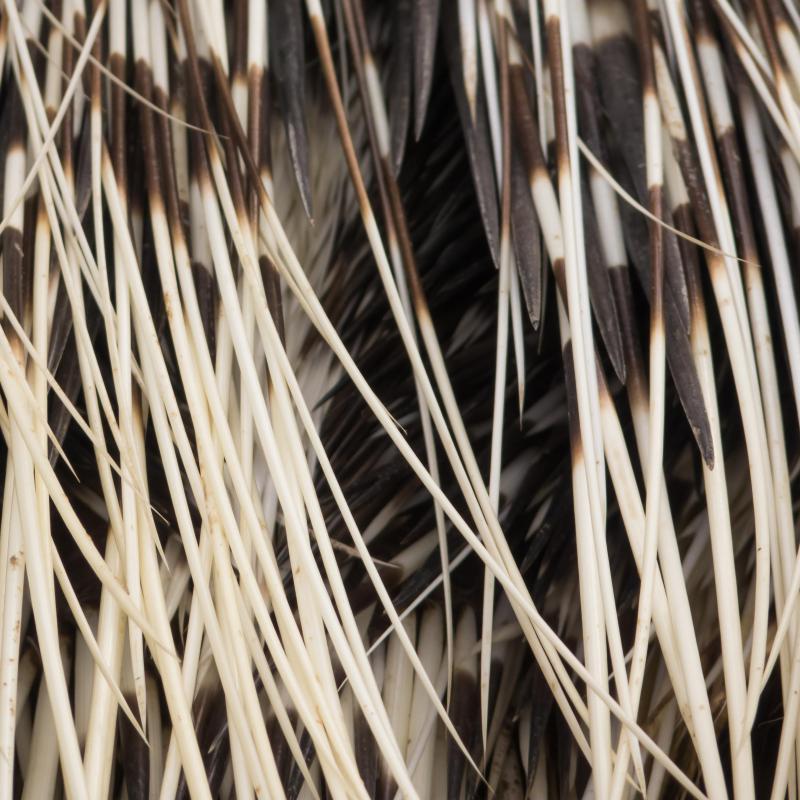At AllThingsNature, we're committed to delivering accurate, trustworthy information. Our expert-authored content is rigorously fact-checked and sourced from credible authorities. Discover how we uphold the highest standards in providing you with reliable knowledge.
What is a Porcupine?
A porcupine is a type of rodent native to parts of Asia, Africa, North and South America and Italy. Porcupines tend to live in temperate climates and are characterized by their coat of spikes or quills. In fact, their name makes reference to this feature, as porcupine is derived from Old French porc d'espine, meaning "spiked pig."
There are 330 species of porcupine, and they may be brown, grey, or, rarely, white. Porcupines have tails measuring about eight to ten inches (20-25 cm) and a round body weighing anywhere from 12 to 60 pounds (5-27 kg). Most are slow-moving, but some varieties in the Americas are agile climbers. There are two basic types of porcupine: the so-called Old World and New World varieties, characterized by the hemisphere to which they are native. The two branches of the porcupine family are actually not closely related, and their quills are not inherited from a common ancestor, but rather an example of convergent evolution, meaning both groups developed the trait independently.

Old World porcupines are mostly terrestrial, meaning they live on the ground, and are quite large. The Crested Porcupine of North Africa and Italy is the fourth largest rodent and can weigh as much as 60 pounds (27 kg). New World porcupines are much smaller, and many varieties live in trees. One exception is the Common Porcupine of Alaska, Canada and the Northern United States, which is terrestrial and weighs up to 40 pounds (18 kg). The two branches of porcupines also differ in that Old World porcupines have quills grouped in bunches, while New World porcupines have individually attached quills. Neither variety of porcupine can throw their quills, although it is a common misconception that they can.

The quills of porcupines are modified hair shafts that evolved as a defense against predators. While the porcupine shares this trait with the hedgehog, the two animals are not to be confused. Unlike the porcupine, the hedgehog is not a rodent, but an insectivore.
Frequently Asked Questions
What is a porcupine and where can it be found?
A porcupine is a rodent known for its coat of sharp spines, or quills, that defend it against predators. They inhabit a variety of climates and terrains across North and South America, Africa, and Asia. North American porcupines are primarily tree-dwellers, while their African counterparts are adapted to life on the ground.
How does a porcupine use its quills for defense?
Porcupines use their quills as a defense mechanism. When threatened, they raise and fan out their quills to appear larger. If contact occurs, the quills can detach and embed in the attacker. Contrary to myth, porcupines cannot shoot their quills; contact is necessary for the quills to dislodge.
What do porcupines eat?
Porcupines are primarily herbivores. Their diet consists of leaves, herbs, twigs, bark, and green plants. In the winter, they may chew on wood and tree bark, which can lead to conflicts with humans when they damage timber or ornamental trees. They have a strong preference for salt and may gnaw on objects with salt residues.
How do porcupines reproduce and raise their young?
Porcupines have a slow reproductive rate, typically breeding once a year. After a gestation period that varies by species (up to 210 days for North American porcupines), a single well-developed offspring is born. The young are cared for by their mother and are born with soft quills that harden within hours.
Are porcupines social or solitary animals?
Porcupines are generally solitary creatures, especially the North American species. They come together only to mate and do not form lasting social bonds. Some species, like the African porcupine, may display more social behavior, living in small family groups. Solitude helps reduce the risk of quill injury within the species.
What threats do porcupines face in the wild?
Porcupines face threats from natural predators like fishers, martens, and big cats, which have learned to attack them from the front, avoiding the quills. Human activities pose a significant threat through habitat destruction, vehicle collisions, and hunting for their quills and meat. Conservation efforts are crucial for protecting their habitats and ensuring their survival.
AS FEATURED ON:
AS FEATURED ON:












Discussion Comments
What are a porcupine's natural defenses?
I just took some pictures of a white porcupine a couple of days ago. I would like to know where I can get these published so everyone else can see it too?
Post your comments